

09/2005
Drawing the Line
by James B. Atkins, FAIA, and Grant A. Simpson, FAIA
It may surprise some people to hear that the architect’s documents cannot be used for construction. Many are of the opinion that the architect prepares the documents and gives them to the contractor, and the contractor takes them and builds the building from the information contained therein. But nothing could be farther from the truth.
 Then
why does the architect place on the documents “Issued for
Construction”? Although common practice, this phrase, when affixed
to the architect’s drawings, can be misunderstood. Nevertheless,
this phrase is better than labeling them “100% CD Set,” “Final
Construction Documents,” or something equally misleading. The documents
are not issued for construction per se, but instead, they are issued
to facilitate construction by expressing the design concept. The documents
do not contain sufficient information to construct the project, and much
more information is required before the work can be done.
Then
why does the architect place on the documents “Issued for
Construction”? Although common practice, this phrase, when affixed
to the architect’s drawings, can be misunderstood. Nevertheless,
this phrase is better than labeling them “100% CD Set,” “Final
Construction Documents,” or something equally misleading. The documents
are not issued for construction per se, but instead, they are issued
to facilitate construction by expressing the design concept. The documents
do not contain sufficient information to construct the project, and much
more information is required before the work can be done.
In fact, the architect’s documents only represent information sufficient for the contractor to begin “the contractor’s required work,” which includes the preparation of detailed construction documents, more commonly known as shop drawings and submittals, coordination drawings, and alternate sketches, all of which set out the specific and final details required for procuring and placing the finished work. By contrast, drawings by architects merely reflect the finished design of the work.
This article will examine the role contractor-provided construction documents play in the construction process, along with the other information that is required to complete a project. It will examine why the design professional’s documents cannot be used as the actual documents for implementing construction, and it will explore what information is actually used, why it is used, and from where it originates.
The architect’s design is a concept
As defined by Webster’s, the term “concept” is “an
abstract or generic idea.” This definition makes it clear that
a concept is not a specific or finite solution with tangible parameters.
The limited content of the architect’s drawings is more explicitly addressed in The Architect’s Handbook of Professional Practice, 13th Ed., in Section 13.4, “Construction Documents Production,” wherein it states: “It is important that all parties understand that construction documents are not intended to be a complete set of instructions on how to construct a building. Construction means, methods, techniques, sequences, procedures, and site safety precautions are customarily assigned as responsibilities of the contractor to give the contractor full latitude in preparing bids and carrying out the construction phase.”
 Similarly,
Section 3.12.4 of AIA document A201, General
Conditions of the Contract for Construction states that the
inherently conceptual nature of construction documents prepared by
architects and the related responsibilities of the contractor/construction
manager for detailed submittals and shop drawings: “Shop Drawings,
Product Data, Samples and similar submittals are not contract documents.
The purpose of their submittal is to demonstrate for those portions
of the work for which submittals are required by the contract documents
the way by which the contractor proposes to conform to the information
given and the design concept expressed in the contract documents.”
Similarly,
Section 3.12.4 of AIA document A201, General
Conditions of the Contract for Construction states that the
inherently conceptual nature of construction documents prepared by
architects and the related responsibilities of the contractor/construction
manager for detailed submittals and shop drawings: “Shop Drawings,
Product Data, Samples and similar submittals are not contract documents.
The purpose of their submittal is to demonstrate for those portions
of the work for which submittals are required by the contract documents
the way by which the contractor proposes to conform to the information
given and the design concept expressed in the contract documents.”
Moreover, Section 3.12.6 of A201 addresses the relationship of the contractor’s submittals and shop drawings to the contractor’s plan for procuring and placing the work: “By approving and submitting Shop Drawings, Product Data, Samples, and similar submittals, the Contractor represents that the Contractor has determined and verified materials, field measurements, and field construction criteria related thereto, or will do so, and has checked and coordinated the information contained within such submittals with the requirements of the Work and of the Contract Documents.”
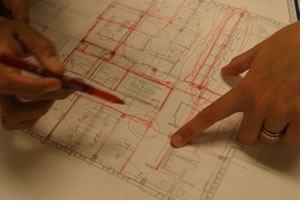 This powerful language explicitly requires the contractor to first check
each submittal and coordinate it with field conditions and the requirements
of the work before submitting it to the architect or engineer to review
for conformance with “the information given and the design concept
expressed in the contract documents.” MasterSpec, a product of
the AIA and the industry standard for construction specifications, devotes
an entire section on project management and coordination (Section 01310, “Project
Management and Coordination”). This description of the content
of coordination drawings explicitly requires them to be original, detailed
comparisons of the various trades, and it recognizes that the architect’s
drawings will likely be in conflict with selected equipment and required
clearances to the extent that coordination is necessary and advisable.
The contractor is specifically directed to provide sketches for resolution
of such predictable conflicts.
This powerful language explicitly requires the contractor to first check
each submittal and coordinate it with field conditions and the requirements
of the work before submitting it to the architect or engineer to review
for conformance with “the information given and the design concept
expressed in the contract documents.” MasterSpec, a product of
the AIA and the industry standard for construction specifications, devotes
an entire section on project management and coordination (Section 01310, “Project
Management and Coordination”). This description of the content
of coordination drawings explicitly requires them to be original, detailed
comparisons of the various trades, and it recognizes that the architect’s
drawings will likely be in conflict with selected equipment and required
clearances to the extent that coordination is necessary and advisable.
The contractor is specifically directed to provide sketches for resolution
of such predictable conflicts.
Furthermore, A201 places the contractor in charge of determining how the work will be divided into separate trades, how the work will be bid and purchased, how the purchased products and systems will be coordinated and incorporated into the completed work, and that the work will be in conformance with the design concept expressed in the contract documents.
When an RFI is not a change order
Although AIA document A201 makes the lines of responsibility for planning
the implementation of the work abundantly clear, and MasterSpec sets
out specific requirements for accomplishing the task, some assert that
a contractor’s change order is justified whenever information
is not specifically expressed in the architect’s documents. As
a result, contractors routinely make these assertions through the RFI
process and inevitably write change orders to add information to the
architect’s documents—information never rightfully required
or intended to be there in the first place.
For example, an architect has indicated “recessed fire extinguisher cabinet” on an interior wall elevation in the architectural drawings. While no specific dimensions are indicated for the cabinet location, the specifications list several acceptable manufacturers for the cabinet. Still, the contractor submits an RFI: “Please provide detail for cabinet framing in wall.”
 In
this instance, the contractor should provide the final answer since the
size and mounting detail of a recessed fire extinguisher cabinet varies
with the manufacturer. The architect could not have precisely detailed
the installation without knowing which manufacturer’s
cabinet was to be used. Also, it is not necessary for the architect to
provide a framing detail because the manufacturer’s literature
describes how the cabinet is to be installed. If the architect answers
the RFI with a framing detail, it is likely that the contractor will
ask for additional money for the newly detailed framing, alleging that
scope was added to the drawings. If the architect doesn’t answer
the RFI he or she risks being accused of not being responsive. One appropriate
response is to suggest that the contractor honor the manufacturer’s
instructions for the selected product.
In
this instance, the contractor should provide the final answer since the
size and mounting detail of a recessed fire extinguisher cabinet varies
with the manufacturer. The architect could not have precisely detailed
the installation without knowing which manufacturer’s
cabinet was to be used. Also, it is not necessary for the architect to
provide a framing detail because the manufacturer’s literature
describes how the cabinet is to be installed. If the architect answers
the RFI with a framing detail, it is likely that the contractor will
ask for additional money for the newly detailed framing, alleging that
scope was added to the drawings. If the architect doesn’t answer
the RFI he or she risks being accused of not being responsive. One appropriate
response is to suggest that the contractor honor the manufacturer’s
instructions for the selected product.
Benefits of conceptual design drawings
AIA documents have expressly indicated for many years that the architect’s
drawings are conceptual, and they have required contractors to represent
through their review of shop drawings that they have “determined
and verified materials, field measurements, and field construction criteria.” These
actions naturally preclude “scaling” the design drawing directly
by attempting to determine dimensions from the drawings with the use
of an architect’s ruler.
In the 1980s, Gyo Obata, FAIA, one of the founding partners of Hellmuth, Obata + Kassabaum Architects (HOK), decided to produce construction drawings in freehand, thus emphasizing their conceptual nature. This forced the contractors to rely on their work plan and the skills of their trades to produce shop drawings to demonstrate how they intended to “conform to the information given and the design concept expressed in the contract documents.”
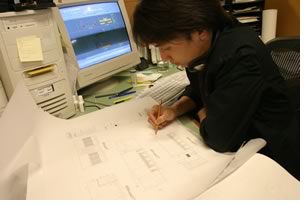 Although
considered by some to be extreme at the time, Obata did not remove any
usable information from his documents. He merely added a human factor
to his line work that expressed the information in its simplest and most
obvious form, while at the same time underscoring the reality that the
architect’s documents are conceptual. By contrast,
today’s computerized document production does little to reinforce
the conceptual nature of design drawings. While computers bring a high
level of consistency and efficiency to the architect’s work, design
drawings rendered via computer are so crisp and precise as to appear
to have the precision of a shop drawing.
Although
considered by some to be extreme at the time, Obata did not remove any
usable information from his documents. He merely added a human factor
to his line work that expressed the information in its simplest and most
obvious form, while at the same time underscoring the reality that the
architect’s documents are conceptual. By contrast,
today’s computerized document production does little to reinforce
the conceptual nature of design drawings. While computers bring a high
level of consistency and efficiency to the architect’s work, design
drawings rendered via computer are so crisp and precise as to appear
to have the precision of a shop drawing.
As is obvious to most architects, there are many benefits to the use of conceptual design drawings in the construction process. Some of these benefits are that it:
- Promotes competition. Multiple acceptable manufacturers allow the contractor to obtain the best price or best delivery schedule. It is generally acknowledged that a single-source specified product will be more expensive because of the lack of competition, and that is why it is unlawful on public projects in many states.
- Provides for the latest technology. A manufacturer’s product may undergo model and specification changes after the project is designed and before the work is installed. A good example is radiology equipment, where specifications and features change almost monthly, and medical technologists and radiologists desire the latest model for their facility. The architect’s conceptual design allows for product procurement with more recent upgrades and developments.
- Allows the trade to determine the final configuration. While architects have a general familiarity with many products, the trade contractor is the expert, knows the product best, and is more capable of determining its ultimate design configuration.
- Places responsibility for means and methods with an experienced provider. Much like the designer’s expertise that is accrued from years of experience, the contractor’s expertise in the latest construction techniques and how products and buildings go together is a career endeavor. The contractor knows best how to develop a plan for making the design concept a built reality.
The contractor’s plan
is critical
The contractor’s plan for procuring and placing the work is not
always entirely visible to the project team. Although the contractor
is required by the construction contract to submit shop drawings, produce
coordination drawings, provide sketches to resolve dimensional conflicts,
and hold pre-installation conferences—all of which the architect
should be aware of and may attend—for the most part, the contractor’s
work plan is transparent.
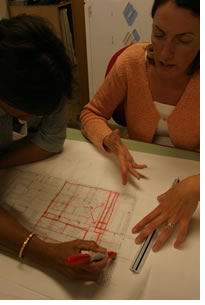 Components of the contractor’s plan for the work are addressed
in Guidelines for a Successful Construction
Project, a joint publication
of The Associated General Contractors of America, the American Subcontractors
Association, and the American Specialty Contractors. Pre-installation
conferences and coordination of subcontractors are addressed in Section
D.2.a (“Guideline on Communications”): “Coordination
should be assured through regular on-the-job meetings of the general
contractor’s authorized project representative and the on-site
subcontractors’ authorized project representatives. Additional
meetings may be required for subcontractors whose work might interfere
with another at a given time.”
Components of the contractor’s plan for the work are addressed
in Guidelines for a Successful Construction
Project, a joint publication
of The Associated General Contractors of America, the American Subcontractors
Association, and the American Specialty Contractors. Pre-installation
conferences and coordination of subcontractors are addressed in Section
D.2.a (“Guideline on Communications”): “Coordination
should be assured through regular on-the-job meetings of the general
contractor’s authorized project representative and the on-site
subcontractors’ authorized project representatives. Additional
meetings may be required for subcontractors whose work might interfere
with another at a given time.”
This publication—formerly known as the Construction Industry Survival Kit—also includes shop drawings and submittal data and coordination drawings as primary topics for discussion during the pre-construction conference. In Section 6.1 (“Guideline on Preconstruction Conferences”), under Topics for Discussion, is Item 4: “Shop drawing and sample submittal data including procedures for submittal, review, and approval . . . ” Item 5 mentions coordination drawings, which are referred to as interference and composite drawings: “Requirements, if any, for interference and/or composite drawings. Who initiates them and what will be the order of progression of these drawings; what is the impact on time for performing the work if composite drawings are required?”
Through such publications, these major construction trade associations acknowledge the role of the contractor in developing and managing the work of coordinating the subcontractors and providing composite coordination drawings. They also recognize that time and planning will be required to coordinate the subcontractors and prepare the drawings necessary to facilitate constructing the work.
The contractor’s plan is critical to the success of a project, and it is developed and implemented by the contractor’s staff. Yet contractors sometimes reduce staff as they seek to control general conditions costs or because of pressure from owners to reduce expenses. Owners often view these temporary facilities and services as transient, with no sustaining benefit to the project. However, efforts to reduce these costs can be misguided and may adversely affect the project. Staff reductions are not made because planning the work is not required, and consequently the work must be provided by an alternate source. For survey and layout services, a common practice today is to buy layout work from the individual trades performing the work. For example, the plumber may be contracted to measure and lay out the locations of plumbing fixtures and equipment, and the drywall contractor may be contracted to measure and lay out the walls.
 Under
this scenario, where layout is not provided as a general conditions service,
the ability of the contractor to confirm that the plumber’s
layouts are compatible with the drywall contractor’s layouts is
reduced. Typically, there are issues of coordination that must be worked
through between the two subcontractors. Since the layout process has
essentially bypassed the contractor’s supervision and control,
it is not a part of the work plan, and the subcontractor’s source
for layout information apparently becomes only the architect’s
drawings. Consequently, if there is a problem with coordinating the layout
between the subcontractors, the architect is often mistakenly viewed
as the responsible party.
Under
this scenario, where layout is not provided as a general conditions service,
the ability of the contractor to confirm that the plumber’s
layouts are compatible with the drywall contractor’s layouts is
reduced. Typically, there are issues of coordination that must be worked
through between the two subcontractors. Since the layout process has
essentially bypassed the contractor’s supervision and control,
it is not a part of the work plan, and the subcontractor’s source
for layout information apparently becomes only the architect’s
drawings. Consequently, if there is a problem with coordinating the layout
between the subcontractors, the architect is often mistakenly viewed
as the responsible party.
The contractor is responsible for subcontractors’ work
According to Section 3.3.2 of AIA document A201, the general contractor
is solely responsible for the acts of subcontractors and the coordination
of their work: “The Contractor shall be solely responsible for
and have control over construction means, methods, techniques, sequences,
and procedures and for coordinating all portions of the Work under
the Contract . . . ”
Coordination of the subcontractors by the contractor is contractually required, and it is necessary for producing properly placed work. Attempting to transfer the responsibility for coordinating the work to the architect is in conflict with the general conditions, the recommendations of the leading trade associations, and, although it may be a common occurrence, it is not good construction practice.
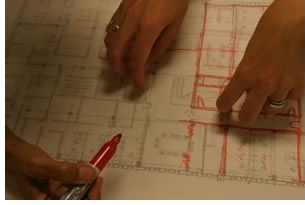 The
issue of pressuring contractors to reduce their general conditions costs
has seemingly played a part in causing layout and coordination of the
work by the contractors in the field to become a vanishing art. The act
of developing a work plan, working with and coordinating subcontractors,
and answering their questions has instead evolved into an intensive RFI
exchange often designed to force the architect to provide some or all
of the contractor’s field coordination services under duress. This
act of conscripting the architect or engineer is inherently unsuccessful
because they do not possess the contractor’s skills or contractual
authority, and they do not provide supervision. In the construction process,
there is simply no substitute for the contractor’s work plan.
The
issue of pressuring contractors to reduce their general conditions costs
has seemingly played a part in causing layout and coordination of the
work by the contractors in the field to become a vanishing art. The act
of developing a work plan, working with and coordinating subcontractors,
and answering their questions has instead evolved into an intensive RFI
exchange often designed to force the architect to provide some or all
of the contractor’s field coordination services under duress. This
act of conscripting the architect or engineer is inherently unsuccessful
because they do not possess the contractor’s skills or contractual
authority, and they do not provide supervision. In the construction process,
there is simply no substitute for the contractor’s work plan.
The following RFI reflects the occasional passive nature of how a contractor might attempt to conscript the services of an architect: “Embeds for the roof screen wall support column bases were set per unapproved shop drawings in the interest of schedule. Please provide a detail for attaching the column base plates with drilled epoxy inserts.”
The contractor should have engaged an engineer to design a correction to this placement mistake and proposed an alternate sketch for the engineer of record to review as MasterSpec requires. Nevertheless, the design team, in an effort to assist in resolving the problem, responded by sending an Architect’s Supplemental Instruction (ASI) with a detail for the inserts as requested. At the end of the project, adding insult to injury, the contractor submitted additional costs in a change order request for “providing inserts per the architect’s revised detail” that was attached to the ASI, alleging that the detail was not the most cost-effective solution.
Systems may be conceptually equal but nominally different
Both the architect’s drawings and the contractor’s procurement
and placement plan, which includes submittals and shop drawings, are
affected by the proprietary nature of the specific materials and systems
that the contractor decides to purchase. In the absence of a sole-source
specification, the architect cannot be expected to know exactly which
suppliers, manufacturers, or subcontractors the contractor will select
to include in the project. The proprietary nature of today’s market
dictates that one vendor’s product will not exactly match another
vendor’s product. Thus, the architect details the concept of an
installation and specifies the products or systems advertised or known
to be conceptually equal in quality. The contractor is responsible for
determining and defining specifically how the conceptually equal but
nominally different products or systems that have been chosen for use
in the project will be incorporated into the work.
An example of a conceptually equal but nominally different product can be found in the case of two popular manufacturers of metal clad wood windows. Both Pella and Andersen manufacture a wood window nominally sized 3’ wide by 5’ high. However, the actual window provided by Pella is 3’ 1” wide by 4’ 11” high, and the window provided by Andersen is 2’ 11-1/2” wide by 4’ 11-1/2” high.
Although the windows are of slightly different sizes, the differences do not invalidate the concept of a 3’ by 5’ window. Thus, without advance knowledge of exactly which window the contractor will propose to buy, the architect can approximately, but not exactly, represent in the design documents what is required for the project. The subcontractor then indicates in submitted shop drawing exactly how the selected window will be incorporated into the work. The shop drawing, although it is not a “contract document,” becomes the document that is actually used for construction. The architect’s documents, since they are conceptual, are not and cannot be the actual documents from which construction is performed.
In another example, the conceptually equal but nominally different nature of the final product to be provided is actually of little concern to the architect, provided the contractor coordinates the work of the subcontractors.
RFI Question: Fire/smoke dampers have been approved as 120 volt. The security system subcontractor has requested permission to change these dampers to 24 volt. Will this change be acceptable?
Engineer’s Response: 120 volt or 24 volt is acceptable. Subcontractors shall coordinate per contract.
As long as the dampers are coordinated and function with all related systems, they will be in compliance with the design concept.
The contractor confirms the architect’s
dimensions
The purpose of the dimensions given in the architect’s drawings
is to define the limits of and provide guidance for placement of the
elements of the work. If there is a category of information provided
in an architect’s drawings that must be used directly during the
construction process, it is likely to be dimensional information. Nevertheless,
the architect’s dimensions must be thoroughly examined and verified
by the contractor preparing the plan for procuring and placing the work
because of the variables in available products and construction techniques.
Therefore, the dimensions provided by the architect are presented only in support of the design concept. Column grids and building limits may be presented and used literally as long as they have been confirmed by the contractor’s surveyor. However, standard convention dictates that the architect may use certain nominal dimensions that the contractor must interpret in actual terms. For example, an 8” concrete masonry unit is actually 7-5/8” tall, and a 2x4 wood framing member is actually 1-1/2” by 3-1/2”.
Dimensions are also impacted by nominal proprietary differences as in the case of the window size example given above, or in the case of small differences in the actual dimensions of kitchen appliances, plumbing fixtures and accessories, floor tile, elevators, and many other products. These nominally differing dimensions, when they have a critical impact on the layout of the building, must be highlighted in submittals, resolved through the RFI process, or, in most cases, merely coordinated by the contractor or subcontractor on site.
A good example of such a condition is pipe penetrations in the building structural frame. The specifications often require “sleeve layout drawings” to be submitted with the structural shop drawings. The contractor is in the best position to determine specifically where the sleeves for the piping can be placed so as to not interfere with critical structural members such as reinforcing steel or post-tensioning tendons, or with the contractor’s provisions for constructability. The architect need not be concerned about the precise location of the sleeve as long as it falls within a wall or chase and meets the requirements of the design concept.
 Convention and common sense also allows that some building elements
may simply be “conceptually indicated” but not actually dimensioned.
Building elements often indicated without dimensions commonly include
doors occurring in a long run of wall, electrical outlets whose specific
location is not critical, and other such elements. The final “nominal” location
of these building elements is rightfully left to the discretion of the
contractor.
Convention and common sense also allows that some building elements
may simply be “conceptually indicated” but not actually dimensioned.
Building elements often indicated without dimensions commonly include
doors occurring in a long run of wall, electrical outlets whose specific
location is not critical, and other such elements. The final “nominal” location
of these building elements is rightfully left to the discretion of the
contractor.
How it is supposed to work
When things go the way they are supposed to, the architect’s interaction
is essentially one of answering questions about design intent and possibly
issuing a few supplemental instructions. The contractor significantly
marks up submittals, and pre-installation conferences are held at the
contractor’s request rather than having the meetings required in
the specifications. If all went as intended, a project would go something
like this:
- Architect designs project and issues design drawings (drawings locate, specifications establish quality)
- Contractor develops plan for procuring the work and allocates work among trades
- Contractor and trades develop a plan for placing the work and prepare composite coordination drawings and alternate sketches
- Trades prepare submittals and submit to contractor
- Contractor coordinates trade submittals with the plan for the work, marks up and approves submittals, and submits to architect
- Architect reviews submittals for conformance with design concept
- Contractor and trades construct with approved submittals
- Contractor issues RFIs for questions that cannot be answered from the information given or for questions about discrepancies in the architect’s documents
- The architect responds to RFIs with answers to questions.
If a project was indeed constructed as the AIA documents anticipate, there would be less paperwork, fewer meetings, and fewer conflicts and disagreements. There may be higher general conditions costs to cover the contractor’s necessary labor, but there would be fewer coordination issues, fewer reimbursable expenses for the owner to pay, and a shorter period to close out the project. Although the contractor’s plan for procuring and placing the work is not a frequent topic of conversation around the job site or in the project meeting, there are contractors that actually prepare such a plan and execute it as the AIA and the leading construction trade associations recommend. The telltale signs are marked-up trade submittals, detailed coordination drawings, fewer RFIs, more installation conferences, and less correspondence in general.
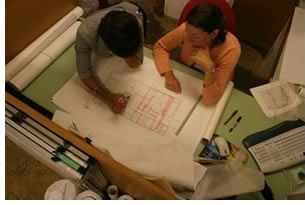 Architects conceive the concept, contractors plan the work
Architects conceive the concept, contractors plan the work
Contractor-provided construction documents are essential for constructing
a project, and it is evident that the architect’s drawings alone
cannot be used because they are conceptual in nature and inherently
inadequate for that purpose. If design drawings were sufficiently complete
and adequate for construction, there would be no need for the general
contractor. The architect would be providing the plan for putting the
work in place. The manufacturer and model along with the precise specifications
and physical characteristics of all products and systems in the building
would be known and detailed in the drawings in advance. In developing “a
complete set of instructions for building the building” the architect
would already have determined the means and methods for placing the
work. There would be no submittals because all data would be fully
anticipated and addressed in the contract documents. There would be
no RFIs, no ASIs, and much less correspondence overall. Moreover, project
costs would likely increase due to the absence of competition.
While the Building Information Model may improve the coordination process in the future, the need for a contractor’s work plan will never go away. Graphically illustrated concepts, desires, and intentions will never precisely match constructed fact. By its very nature, the construction process requires that someone plan, schedule, coordinate, and direct the means and methods necessary for project construction and completion.
Architects will continue to design projects and produce conceptual drawings for the contractor’s use. However, until the industry acknowledges the need and demands that contractors plan and coordinate the work, architects will continue to be expected to coordinate both the contractor and the work of the trades. Until owners are enlightened as to the contractor’s responsibilities under the AIA documents, the misguided expectation that the architect is responsible for coordinating the work will remain. The legal industry will continue to attempt to hold the architect’s conceptual drawings to shop drawing standards, and the number of claims against architects will continue to rise.
Copyright 2005 The American Institute of Architects.
All rights reserved. Home Page ![]()
![]()
